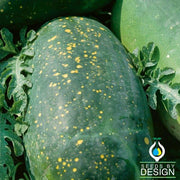DESCRIPTION
Watermelon Seeds - Moon & Stars
Called 'Sun, Moon and Stars' when it was introduced in 1924 by Peter Henderson and Company, the melon had disappeared from the commercial market for decades and was thought extinct when, in 1981, as Goldman notes, Kent Whealy, co-founder of Seed Savers Exchange, was contacted by Merle Van Doren of Macon, Mo., who was growing the melon and gave Whealy some of the seeds from the melons he grew. The Southern Exposure Seed Exchange reintroduced the oblong 'Amish Moon & Stars' and a yellow-fleshed, not-so-sweet variety in 1987.
A heavy watermelon -- ranging from 20 to as much as 50 pounds -- the 'Moon & Stars' has a dark green somewhat ridged rind with the aforementioned yellow mottling. Leaves are similarly mottled. Fruit may be round, oblong or pear-shaped. The flesh, which can be red, pink-red or yellow, depending on the variety, is nowhere near as dense and smooth as that of the commonly grown 'Sugar Baby' or 'Crimson Sweet.' The flesh around the seeds tends to get mealy just when the melon is at its peak, which is the only downside I've found -- although those who like their fruit seedless may balk at the large seeds that surround a small heart. On the other hand, those who eat the nutritious seeds (Goldman notes that watermelons are grown for their seeds rather than the flesh in China and many parts of Africa) will prize 'Moon & Star.
ATTRIBUTES






